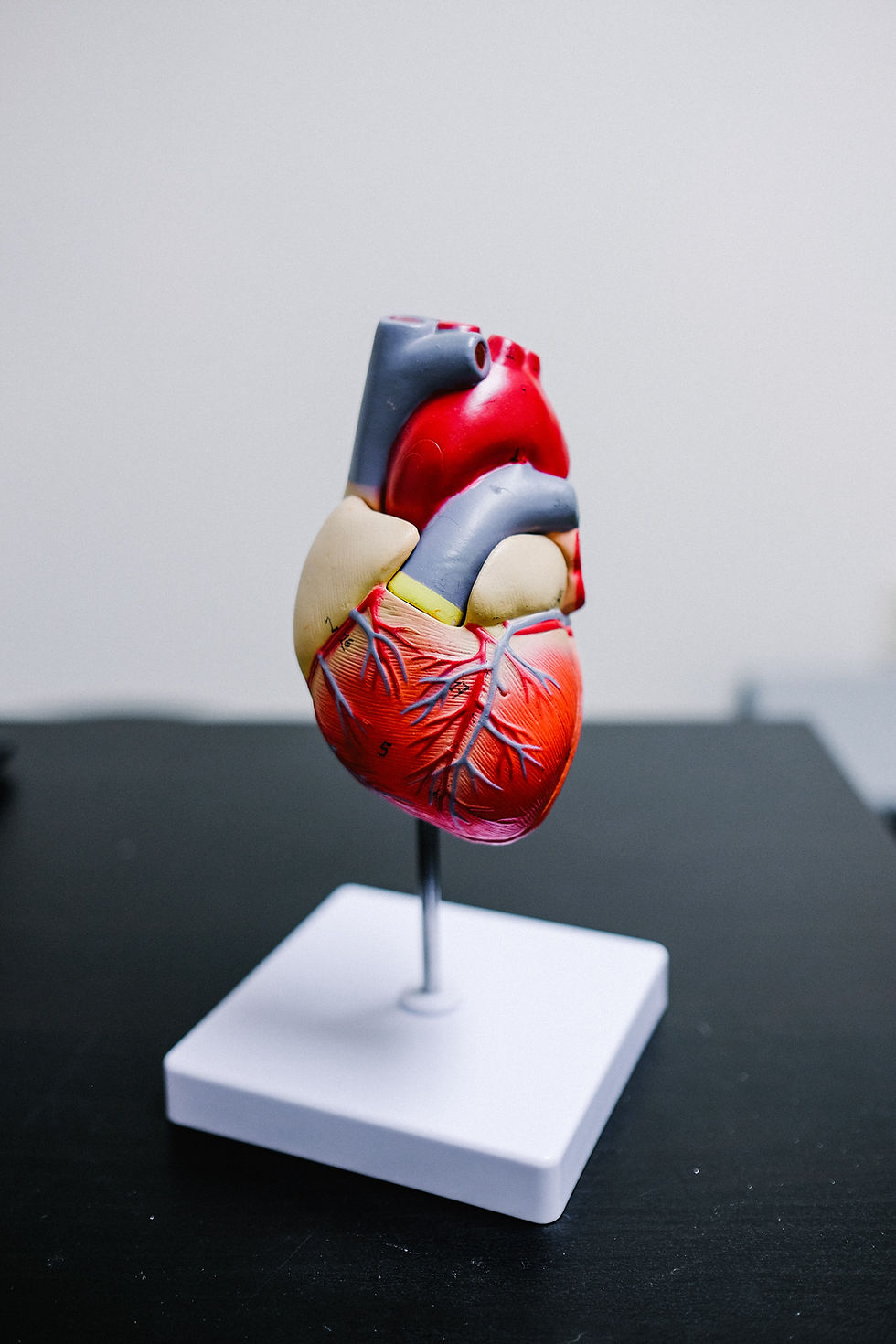Cardiovascular exercise: 7 benefits and 7 tips
- Lainey Greer

- Nov 4, 2019
- 6 min read
Updated: Nov 12, 2019

I know…cardio. Insert eye roll. If you’re anything like me, you despise it. Even still, keep reading and maybe I can convince you it’s worth incorporating into your schedule.
According to the CDC, the leading killer of men and women every year is heart disease. In fact, 1 out of every 4 deaths is due to heart disease. The major contributors to heart disease are high blood pressure, high cholesterol, diabetes, and being overweight or obese – diseases that are all too prevalent in America. (check this out for more information about these diseases and Southern Baptists)
But guess what benefits most from cardiovascular work? Drum roll please…your cardiovascular system!! The cardiovascular system consists of the heart, arteries, veins, and capillaries. This system works to pump blood and vital nutrients through the body. So one of the best ways to stave off heart disease is to work the heart and walk, run, bike, swim, row, skate, jump rope, skip, hop, etc. We typically identify these activities as cardio, but really anything that gets your heart rate up and causes you to breathe heavier should be considered cardiovascular work. You can even structure a weight lifting routine in a way that elevates your heart rate. There are numerous forms of cardio, and each comes with several benefits.
The following are 7 benefits of cardio:
1. Increases the strength of your heart – Did you know your heart is a muscle? Cardio makes it stronger. The stronger your heart is, the more blood it pumps out with each beat, called stroke volume. The volume of blood the heart pumps out each minute is called the cardiac output. So the stronger your heart is, the more blood it pumps with each beat, which in turn lowers your heart rate. This is huge because it means your heart will not have to work as hard to pump blood throughout your body.
2. Lowers resting heart rate – With a stronger heart comes a decreased heart rate. The optimal range for resting heart rate is 60-80 bpm (beats per minute). You can check this by sitting still or lying down for 15 minutes. Then, take your pulse for a minute. If it’s within that range, your heart is relatively healthy. If it is higher, that likely means your heart is working harder than it needs to be in order to pump blood through your body. Year after year of this extra stress on the heart may lead to a heart attack or stroke down the road.
3. Decreases the chance of chronic disease – The risk of high blood pressure, diabetes, high cholesterol, stroke, heart disease, and obesity all lessen with cardiovascular activities. Maybe you don’t have any of these now, but it is likely you do in your family history. Guard against the development of future chronic disease by engaging in cardio now, especially because these diseases can lead to heart disease – the number one killer of men and women.
4. Decreases stress – Cardio can help clear your mind. It can temporarily transfer your thoughts from a stressful work situation, family problem, or heavy trial to focus them on finishing the next mile or reaching your target heart rate. It also temporarily increases endorphins that positively impact your stress level.
5. Increases VO2 max – You may have never heard of VO2 max, but it is simply the amount of oxygen your lungs are able to take in and utilize with each breath. The higher your VO2 max, the more efficient your respiratory system will be at sustaining cardiovascular activity. If your VO2 max isn’t very high, then you will likely lack endurance. This is because your respiratory system can’t work fast enough to sustain the body’s oxygen needs.
6. Boosts metabolism – Cardio helps your body burns more calories. While its impact is more immediate – where muscle gain from lifting has a more long-term impact on metabolism – it still makes a difference in the calories you burn for that day.
7. Improves flexibility, functional abilities, and joint pain or stiffness – Cardio helps improve the range of motion around your joints. It boosts synovial fluid that lubricates stiff joints, which also increases your flexibility level. Your functional abilities, like everyday tasks, become easier the less joint pain you have and more flexible you are.
Now 7 tips for doing cardio:
1. Sweat – For those of you that don’t like to perspire, you do actually need to sweat when doing cardio. If not, you’re wasting your time! Now, I have met a handful of people who just don’t sweat much even after a legitimately hard workout. But, I also see people leave the gym after 30 minutes on the treadmill who are barely even glistening. A good, sufficient cardiovascular workout will get your heart rate up, which causes your body to begin cooling itself off through sweating.
2. Avoid monotony – Don’t let your cardio routine become monotonous like always swimming 1 mile, walking 2, or running 3. Not only might you lose interest, but your body will also get used to the same activity and stop changing. Repetitive movements from the same type of cardio can even lead to injury – shin splints, plantar fasciitis, even stress fractures are examples.
3. Switch things up – Just like weight lifting, don’t always do the same cardiovascular work. If you always swim, its time to do your cardio on land. If you’re used to walking a mile on a track and have access to stairs, then alternate walking a lap then climbing a set of stairs. If you’re used to running 20 minutes, try the following instead: complete 5 rounds of 4-minute sets doing a 1-minute run, 1-minute of jumping rope, and 2 minutes of rowing.
4. Just start doing something – Maybe you aren’t currently active at all, but there’s good news. You can get going today! You might have a very hectic schedule, but I promise there are always ways you can incorporate a bit more movement in your day. Yes, the recommended step goal is 10,000 every day, but most people get less than half that. You can work towards more steps in easy ways like parking at the back of a parking lot, take the stairs instead of the elevator, or take a longer route when walking the dog in the morning and at night.
5. Set a goal – The baseline amount of cardiovascular activity is 150 minutes a week. Break it up however it’s convenient for you. Maybe it’s 30 minutes, 5 days a week or 50 minutes, 3 days a week. Though regular activity is better, you can even go on a 2-hour weekend hike and knock out a major chunk of that for the week.
6. Calculate your target heart rate (THR) – This will give you an idea of how hard you’re working while walking, swimming, or jogging. Take 220 and subtract your age. This is your maximum heart rate, MHR. Now, take your maximum heart rate and multiply it by 65%, 75%, and 85% to give you a range for assessing the intensity of your workout. Working at 65% will be very easy and sustainable. Moderate intensity work is around 75% of your MHR, while 85% is vigorous intensity and likely an activity you can’t sustain longer than 2 minutes. Here is an example of how to use these percentages. If you’re 50, your MHR is 170 bpm (beats per minute). 65% of your MHR is 111 bpm; 75% is 128 bpm; 85% is 145 bpm. So say you’re jogging, and you want to work up to 75% of your MHR. At some point during your cardio work, pause and take your heart rate for a minute. If it is close to 128 bpm, you’re working at moderate intensity. (The best way to measure your heart rate without it decreasing too much is to take your pulse for 20 seconds and multiply that number by 3.)
7. Interval training – This is the best type of cardiovascular activity. It involves cycling between different intensities, for instance, 65% and 85% of your MHR. Now, you don’t have to do the calculations in tip 6 to do interval training. You can alternate walking a lap and running a lap. Or on an elliptical alternate between 45 seconds of working hard and 15 seconds of going a little easier. Basically, interval training is just alternating a more intense interval with a less intense interval.




Comments